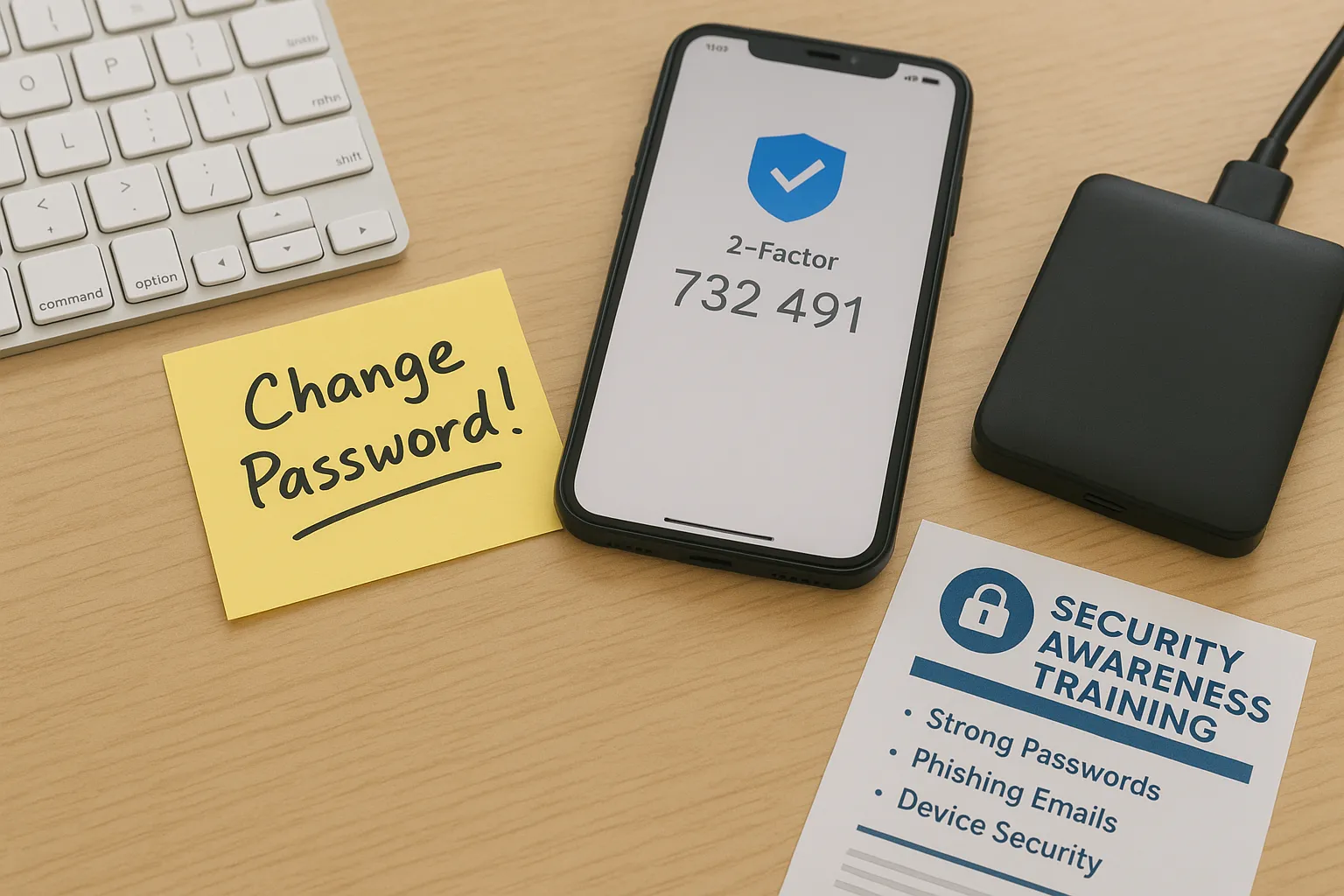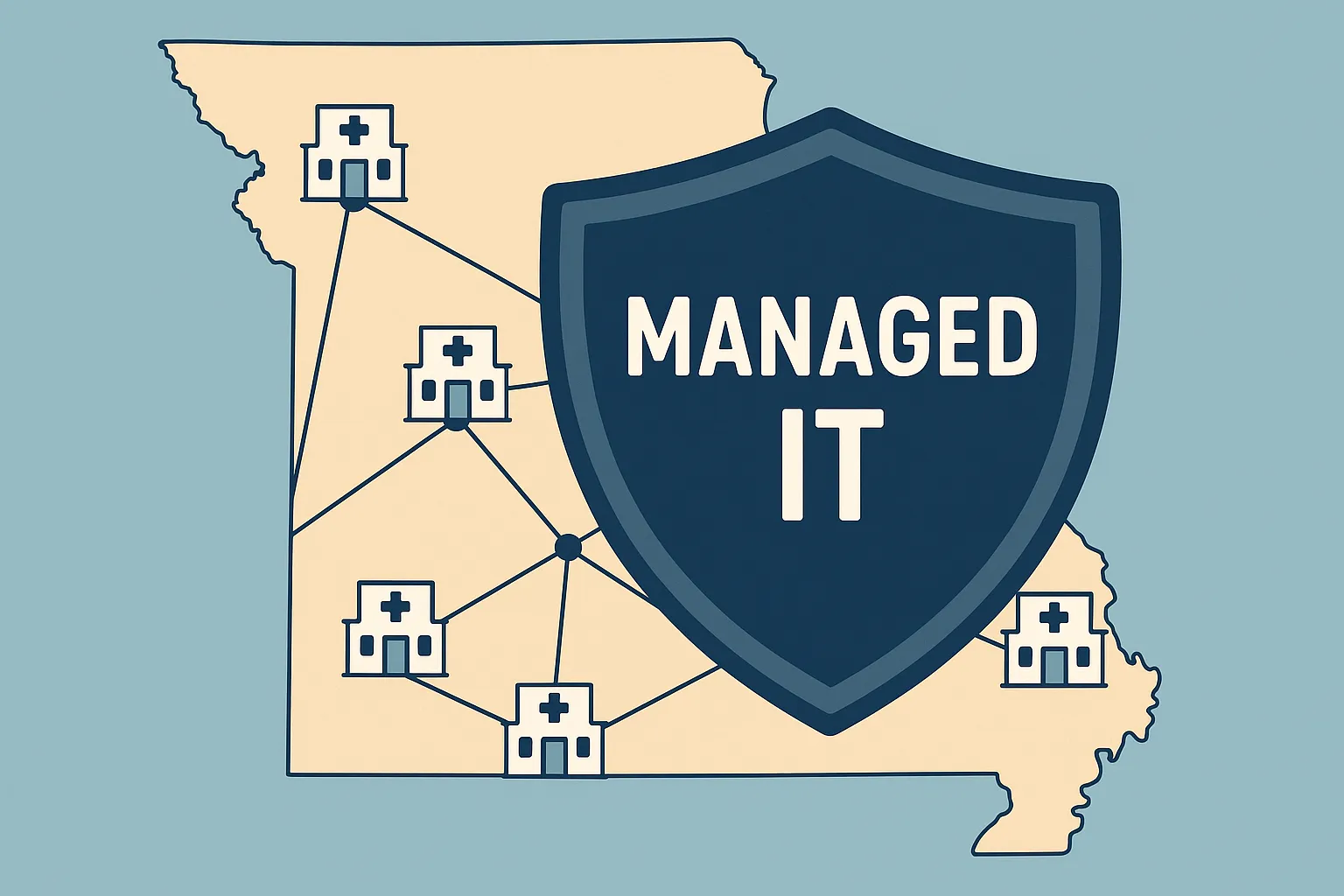Introduction
For rural clinics in areas like Chillicothe, Trenton, Brookfield, Kirksville, and St. Joseph, Missouri, balancing HIPAA compliance with cybersecurity can feel daunting. Limited budgets and IT staff often leave small healthcare practices wondering how to protect patient data without breaking the bank. The reality is that cyber threats don’t skip small or rural clinics – in fact, attackers often see them as easier targets. In this guide, we’ll explore cost-effective IT solutions and best practices to keep your clinic’s data secure and HIPAA-compliant, even with limited resources. A warm, plain-English approach will demystify tech jargon and empower you to take action. Let’s dive in!

Why Rural Clinics Face Unique Cybersecurity Challenges
Rural and small healthcare clinics face the same cybersecurity threats as large hospitals, but with far fewer resources to defend against them. Hackers know this. Nearly three-quarters of small businesses (including clinics) reported a cyber-attack in the past year, with patient data often the target. Small clinics are actually prime targets because they typically have weaker security measures than big hospitals.
Tight budgets and limited IT staff make it hard for rural clinics to implement advanced security. Many are just breaking even financially, and cannot easily afford “enhanced security measures” or dedicated cybersecurity experts. Older computer systems – common in small clinics – may not meet modern security standards, leaving “digital side doors” open for hackers. Meanwhile, staff at a small clinic wears many hats; few have a full-time IT professional on site. This can lead to overlooked software updates, weak passwords, or untrained staff clicking on phishing emails.
Geography adds another layer: clinics in North Missouri (like those around Chillicothe or Kirksville) may face rural connectivity issues and sparse local tech support options. When something goes wrong, help isn’t just down the street – unless you partner with a local IT provider. Being rural doesn’t insulate you from HIPAA obligations either. Regulations apply equally, and HIPAA’s Security Rule requires even small practices to conduct thorough risk assessments and safeguard electronic protected health information (ePHI).
In short, rural clinics must contend with big-city cyber risks on small-town budgets. Understanding these challenges is the first step. Next, we’ll see what’s truly at stake if security falls short.

The High Stakes of HIPAA Non-Compliance and Breaches
Some small practice owners think, “We’re too small; hackers won’t bother us.” Unfortunately, the data says otherwise. Healthcare breaches hit record highs in recent years – 725 large healthcare data breaches (500+ records) were reported in 2024 alone, averaging roughly two breaches every day. No clinic is “too small” to be part of those statistics.
The consequences of a breach or HIPAA violation can be devastating, especially for a small clinic. Patient trust is shattered if their personal health information is compromised. Beyond that, consider the financial impact:
- Hefty HIPAA Fines: Regulators can levy fines up to $50,000 per violation, with annual caps of $1.5 million for repeat violations. Even one breached laptop or one improper record disposal can count as a violation. For a small clinic, those penalties could be ruinous, potentially even forcing closure. Criminal charges are also possible for willful neglect of security rules.
- Data Breach Costs: The cost of dealing with a breach (beyond fines) is sky-high in healthcare. Incident response, patient notifications, legal fees, and lost business add up fast. In fact, the average healthcare data breach costs an astonishing $10.93 million (the highest of any industry). While a small clinic breach might not hit that figure, even a fraction of it – say paying for credit monitoring for affected patients and upgrading systems afterward – can far exceed your annual IT budget.
- Operational Downtime: If ransomware strikes or systems must be taken offline, a clinic can’t access vital EHR (Electronic Health Record) or scheduling systems. Providers can lose access to patient data and billing systems for days or weeks. This means canceled appointments, lost revenue, and frantic workarounds that strain your staff. After one major attack on a healthcare network, 77% of practices experienced service disruptions and 80% lost revenue from unpaid claims.
- Legal and Reputation Damage: Breach notification is mandatory under HIPAA for significant incidents, meaning you must inform patients and HHS (and sometimes the media). The public disclosure can damage your clinic’s reputation. Patients may take their business elsewhere due to fear their data isn’t safe. Lawsuits can follow if patients believe you neglected proper safeguards.
In essence, the cost of doing nothing is far higher than the cost of prevention. As one expert noted, “a breach can cost far more than prevention… doing nothing is always the most expensive option.”. The good news? Preventive security doesn’t have to drain your bank account. With smart strategies, even budget-strapped clinics can drastically reduce their cybersecurity risks.

High-Impact, Low-Cost Cybersecurity Solutions
When resources are tight, focus on affordable measures that yield maximum protection. Below is a small clinic cybersecurity checklist of cost-effective steps to strengthen your defenses and maintain HIPAA compliance. These are practical, budget-friendly actions you can start on right away:
- Enable Strong Passwords and Multi-Factor Authentication (MFA): This is the first line of defense and costs nothing. Require staff to use strong, unique passwords and turn on MFA for email, EHR, cloud services – anywhere it’s available. Simply adding the extra verification (like a smartphone app code) can stop the vast majority of hacking attempts cold. It’s “cybersecurity 101” but incredibly effective.
- Train Your Staff (Phishing Awareness): Humans are often the weakest link. Regular, short training sessions can teach staff how to spot phishing emails, suspicious links, and other scams. This doesn’t require expensive programs – even a free quarterly training or interactive quiz can help. Many cyberattacks start with a single click on a fake email. Teaching employees to recognize phishing attempts can stop a breach before it happens. Also ensure everyone knows not to share passwords and to report strange computer behavior immediately.
- Use Affordable Endpoint Protection: Don’t assume the basic antivirus that came with your PC is enough. Affordable, next-gen antivirus/endpoint security software is available for modest annual fees per device. Solutions like Bitdefender or SentinelOne offer enterprise-grade protection at small-clinic prices. These tools can detect and block malware, ransomware, and other threats proactively. The investment is minor compared to the cost of an incident. Ensure all PCs and tablets in your clinic (and even mobile devices if used for work) have up-to-date security software.
- Keep Software Updated and Patched: It costs only a bit of time to enable automatic updates on your operating systems, EHR software, and devices. Outdated software is easy prey for hackers. Set Windows, macOS, and application updates to auto-install after hours. Include network equipment too – an unpatched wireless router or firewall can be a revolving door for attackers. If you don’t have IT staff, a managed service can handle this (more on that later). Staying current with patches closes known security holes before attackers exploit them.
- Secure Your Email and Messaging: Email is still the #1 entry point for breaches. If you’re using a free or consumer email for work, consider switching to a HIPAA-compliant email service (for example, Microsoft 365 or Google Workspace with a signed Business Associate Agreement). These services can encrypt emails and provide archiving to meet HIPAA requirements. Encryption is key – ensure any emails or texts containing patient info are encrypted end-to-end. Also use email filtering (often built-in or low-cost add-on) to catch spam and known malicious messages before they hit inboxes.
- Protect ePHI on All Devices (Physical & Technical Safeguards): Make sure any computer or device with patient data has basic protections:
- Passwords/Passcodes on every device (no unlocked tablets sitting around).
- Automatic screen lock after a short inactivity.
- Encryption of devices if possible (many modern systems have whole-disk encryption built-in).
- Regular backups of important data: Use an external hard drive or, better yet, a secure cloud backup service. Encrypted cloud backups ensure that even if a device fails or is stolen (or ransomware encrypts your files), you can recover patient data quickly.
- Secure Wi-Fi and Network: Use a business-grade firewall or at least a good wireless router with WPA2/WPA3 encryption. Change default passwords on network gear. Segment Wi-Fi so that guest patients or visitors can’t access your internal network.
- Perform a HIPAA Risk Assessment Annually: This is required by HIPAA and invaluable for prioritizing your security efforts. Essentially, you (or a consultant) systematically review where your patient data is, what risks exist, and how to mitigate them. A thorough risk assessment will uncover gaps – maybe an old server that isn’t backed up, or lack of a policy for lost devices. By identifying these, you can focus limited funds on the most critical fixes first. HHS offers free tools to help conduct a risk assessment, or you can enlist a specialized firm. Many managed IT providers will perform an initial risk assessment at low or no cost as a way to help you roadmap your needs. Don’t skip this – it’s the roadmap to sensible spending.
- Leverage Cost-Effective Tools & Services: You don’t need top-of-the-line enterprise systems. Open-source or low-cost security tools can offer robust protection without a hefty price tag. For example, there are free or affordable versions of password managers, network monitoring tools, and even security information and event management (SIEM) software tailored for small businesses. Use reputable, HIPAA-friendly versions and consult with IT experts on what fits your clinic. Sometimes a $0 solution (open-source) has an active community and can be just as effective as expensive software.
- Document Policies and Procedures: It costs only staff time to write down your procedures for handling ePHI and IT security (and it’s a HIPAA requirement). Create a simple handbook: how to respond if a device is lost, how often to change passwords, who has access to what data. Policies help ensure consistent practice and are a lifesaver if you ever face an audit. Make sure every employee knows the basics (and have them sign an acknowledgment). Update these policies yearly based on your risk assessment findings or any incidents.
- Plan for the Worst (Incident Response): Develop a basic incident response plan – essentially, a step-by-step guide for what to do if a breach or ransomware attack occurs. Identify who to call (IT support, legal, etc.), how to isolate infected systems, and how to communicate with patients if needed. Having a plan doesn’t cost much, but it can dramatically reduce chaos and recovery time in a crisis. Combine this with disaster recovery planning – ensure you have data backups and a way to continue seeing patients if computers go down (even if that means temporarily reverting to paper and phone). This kind of contingency planning can minimize downtime costs.
Each of these steps is relatively inexpensive, especially compared to the cost of a security incident. By focusing on these fundamentals, a small clinic can build a strong security baseline without expensive infrastructure. In fact, many clinics that implement these measures find that they not only prevent breaches but also run their operations more efficiently (less downtime, faster systems, more trust from partners and patients).
Next, let’s look at how clinics can get help implementing these solutions – because you don’t have to do it all alone.

Managed IT Services: A Smart Option for Small Clinics
For many rural clinics, the most cost-effective “solution” is a partnership. If you don’t have the IT staff to manage all the above, consider using a Managed IT Services provider familiar with healthcare. A good provider essentially becomes your outsourced IT department at a predictable monthly cost far lower than hiring full-time personnel.
How can an IT partner like Pinpoint Tech help? For starters, we specialize in healthcare IT and HIPAA compliance, which means we know what a small clinic needs. Here are some benefits of partnering with an expert team:
- Expert Guidance and Risk Management: An experienced provider will conduct a thorough HIPAA risk assessment for you, identify vulnerabilities, and create a tailored mitigation plan. They’ll ensure you check all the compliance boxes – from proper EHR integration security to network safeguards – without overspending on unnecessary extras. You get advice on what to prioritize first (maybe your outdated server or unencrypted laptop) so your dollars have the biggest impact.
- 24/7 Cybersecurity Monitoring: While you focus on patient care, a managed IT service can keep an eye on your systems around the clock. Automated tools can detect suspicious activity (like a possible hacker or malware outbreak) and alert the team to respond immediately. Continuous monitoring and maintenance means many issues are caught – or prevented – before they cause downtime. This proactive approach is something small clinics typically can’t do on their own, but an IT partner can spread out the cost by serving multiple clients.
- Unified Solutions (All-in-One): Instead of juggling multiple vendors, a local IT provider can offer an all-in-one package: secure internet connectivity, firewall management, data backup solutions, cloud services, and support for your EHR and devices. For example, Pinpoint Tech provides secure data backup, advanced firewalls, and on-call support as part of our managed plans, so you’re covered end-to-end. This consolidation often saves money (bundle pricing) and certainly saves headaches, since you have one team to call for anything IT-related.
- Regular Updates and Patching: As mentioned, keeping systems updated is critical. A managed service will handle all your patching, antivirus updates, and hardware upgrades on a schedule – tasks that would otherwise fall through the cracks in a busy clinic. We also help ensure your EHR software is updated and properly integrated with other systems without introducing security holes (often, we coordinate with your EHR vendor so that configurations remain compliant).
- Staff Training and Support: Your IT partner can provide security awareness training for your staff (sometimes even as live sessions or webinars tailored for healthcare). They’ll also be there to answer your staff’s day-to-day tech questions. Instead of spending hours trying to troubleshoot a Wi-Fi issue or printer failure, your staff can call the helpdesk and get it fixed, so they can get back to patients. This boosts productivity and morale.
- Scalability and Planning: As your clinic grows or changes, a managed service provider advises on technology decisions. Need to implement telehealth, or considering a new ePHI system? We help ensure it’s done securely and cost-effectively. Planning a move or expansion in Trenton or Brookfield? We’ll design your network and coordinate the IT so you have a smooth transition. Essentially, you gain a CTO-level advisor who understands both tech and the local context of rural Missouri clinics.
- Rapid On-Site Response: With a local partner like Pinpoint Tech (based in Chillicothe, MO), you also get the advantage of quick on-site support when needed. Remote fixes solve most issues, but if a critical device fails or you need hands-on assistance, we can be at your door fast. That’s something big, far-away IT companies can’t offer. Being local also means we understand regional challenges, like spotty rural internet – we plan around those with solutions like signal boosters or offline backup methods.

Taking the Next Step: Protecting Your Clinic Now
Cybersecurity and HIPAA compliance can be intimidating, but you don’t have to tackle it alone or all at once. Start with the basics we outlined – even a few small improvements can dramatically lower your risk. Change those default passwords, schedule that data backup, run a quick internal audit of who has access to what. Build a culture where security is part of the routine, not an afterthought.
If you’re feeling overwhelmed or not sure where to begin, that’s where we come in. Pinpoint Tech, your local managed IT partner in north Missouri, is here to help rural clinics like yours create a solid, affordable cybersecurity foundation. We understand the budget constraints and the regulations you face. Our team can perform a free initial HIPAA risk assessment for clinics in Chillicothe, Kirksville, St. Joseph and the surrounding region – giving you a clear picture of your strengths and vulnerabilities. From there, we’ll work with you on a plan that fits your needs and your budget.
Don’t wait until a breach happens to act. The stakes are too high, and fortunately, the solutions are within reach. By investing a bit of time and partnering with the right experts, even the smallest clinic can have big-league cybersecurity and rock-solid HIPAA compliance. Your patients trust you with their health; we’ll help you earn their trust with their data.
Ready to safeguard your clinic? Give Pinpoint Tech a call for friendly guidance or to schedule your free consultation. We’re your neighbors, and we’re committed to keeping our community’s healthcare secure and thriving.
Secure your clinic today, so you can focus on what you do best – caring for patients – with peace of mind that their data is safe.

FAQs: HIPAA Compliance and Cybersecurity for Small Clinics
Are small clinics really at risk of cyberattacks?
What is a HIPAA risk assessment and do we need one?
How can we afford cybersecurity on a tight budget?
Start with low-cost or free measures that give the most bang for your buck. For example, enforcing strong passwords and turning on multi-factor authentication costs nothing but greatly improves security. Using free encryption tools for devices and emails, regularly updating your software, and providing staff with basic security training are also high-impact, low-cost steps. Additionally, there are affordable versions of professional security software (antivirus, email filtering) that are priced per user or device – perfect for clinics. Prioritize investments based on your risk assessment: address the biggest risks first. Partnering with a managed IT service can also be cost-effective; instead of hiring IT staff, you pay a flat monthly fee for experts who will handle security and tech maintenance. This often includes a suite of security measures (firewalls, monitoring, backups) bundled at a lower cost than sourcing each service separately. Remember, a single breach could cost far more than years of preventive security – so think of cybersecurity as an investment in protecting your practice’s viability.
Does using a cloud EHR mean our clinic is automatically HIPAA-compliant?
Not by itself. Cloud EHR systems (Electronic Health Records) often come with robust security and a Business Associate Agreement, which helps with HIPAA compliance for that system. However, your HIPAA liability extends far beyond just the EHR. You are responsible for protecting all PHI in your clinic – that includes data in your EHR and data in other places like appointment scheduling software, billing systems, emails, scanned documents, and even verbal discussions. If your staff downloads EHR data to a laptop or prints it out, you must safeguard those, too. A cloud EHR is a great start (since the vendor will handle its security to a point), but you need to ensure proper access controls, strong passwords, and that staff aren’t exporting or using data in insecure ways. Also, other systems (labs, pharmacy communications, etc.) that interface with the EHR need to be evaluated. Think of HIPAA compliance as a clinic-wide effort: the EHR is one piece of the puzzle. Always configure the EHR’s security settings properly (don’t use generic logins, limit access based on role, etc.), and include it in your overall risk assessment.
What should we do if we suspect a data breach or ransomware attack?
Time is of the essence. If you suspect a breach (e.g., lost device, hacker message, unusual system behavior), activate your incident response plan immediately. If you have IT support (in-house or managed provider), call them – they can help verify and contain the issue. Key steps typically include: isolating affected computers (take them off the network to prevent spread), securing backups (to make sure they aren’t infected), and documenting everything you observe. Do not pay any ransom immediately – consult with experts and law enforcement. Under HIPAA, you may need to report the incident to HHS and notify patients, especially if 500 or more individuals are affected, so involve your compliance officer or legal counsel quickly. Having a plan beforehand is crucial – it should list who to contact (IT, legal, HHS, possibly cybersecurity firm) and how to proceed. If you’re a Pinpoint Tech client, for example, we would handle much of this process for you, from technical containment to guiding you on notification steps. The faster you respond, the better chance you have of minimizing damage. After an incident, perform a post-mortem to improve your security and prevent future issues. Remember, HIPAA also requires you to mitigate any harmful effects of a breach, so providing identity theft protection to patients or other remedies might be necessary.
What are some signs that our clinic’s security is too weak?
There are a few red flags that often indicate insufficient security:
- Out-of-date Systems: If your computers still run legacy software (like Windows 7 or an unpatched server), that’s a sign of vulnerability.
- No Written Policies: If you don’t have any written HIPAA security policies or can’t recall the last risk assessment, it’s time to get those in place.
- Frequent Tech Issues: Regular computer crashes, unknown pop-ups, or slow networks might hint at malware infections or poor maintenance.
- Staff are Unaware: If employees haven’t been trained on security in recent memory, they might be making risky mistakes (like weak passwords or improper data sharing) without realizing it.
- Lack of Backups: If you’re not backing up data daily (and offsite), you’re at high risk of data loss.
- No MFA or Encryption: If you’re not using encryption for sensitive data or MFA for remote access, you’re behind current best practices.
If any of these sound familiar, don’t panic – start addressing them one by one. Often bringing in an IT professional for a quick assessment can reveal hidden issues. It’s far better to discover and fix a weakness now than after a breach occurs.
Sources
- IBM Security, “Cost of a Data Breach Report 2024”:
https://www.ibm.com/reports/data-breach - IBM Security, “Cost of a Data Breach – Healthcare Industry”:
https://www.ibm.com/think/insights/cost-of-a-data-breach-healthcare-industry - HIPAA Journal, “2024 Healthcare Data Breach Report”:
https://www.hipaajournal.com/2024-healthcare-data-breach-report/ - HIPAA Journal, “Healthcare Data Breach Statistics”:
https://www.hipaajournal.com/healthcare-data-breach-statistics/ - HHS.gov, “HITECH Act Enforcement Interim Final Rule”:
https://www.hhs.gov/hipaa/for-professionals/special-topics/hitech-act-enforcement-interim-final-rule/index.html - HHS.gov, “Guidance on Risk Analysis” (+ SRA Tool):
https://www.hhs.gov/hipaa/for-professionals/security/guidance/guidance-risk-analysis/index.html - Microsoft, “Digital Defense Report 2023”:
https://www.microsoft.com/en-us/security/security-insider/microsoft-digital-defense-report-2023 - Microsoft Security Blog, “One Simple Action to Prevent 99.9% of Account Attacks”:
https://www.microsoft.com/en-us/security/blog/2019/08/20/one-simple-action-you-can-take-to-prevent-99-9-percent-of-account-attacks/ - StrongDM, “Small Business Cybersecurity Statistics 2025”:
https://www.strongdm.com/blog/small-business-cyber-security-statistics
